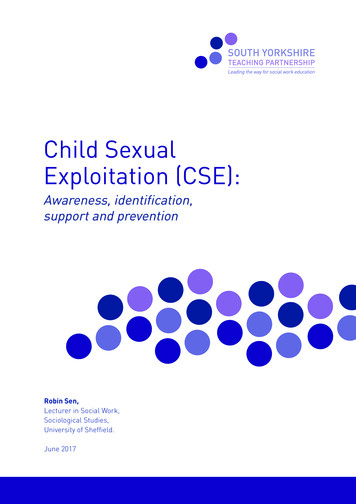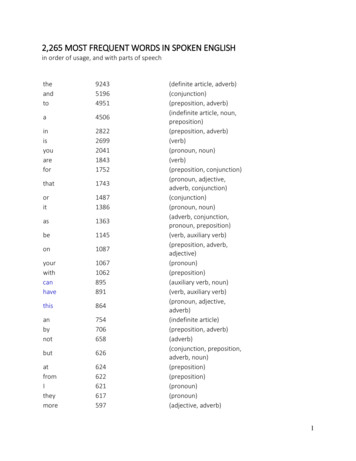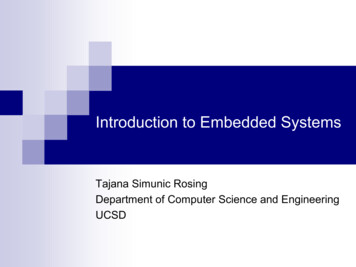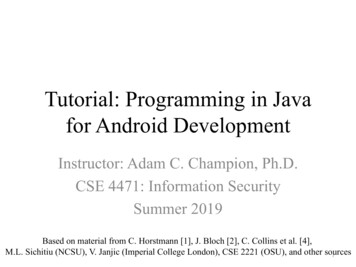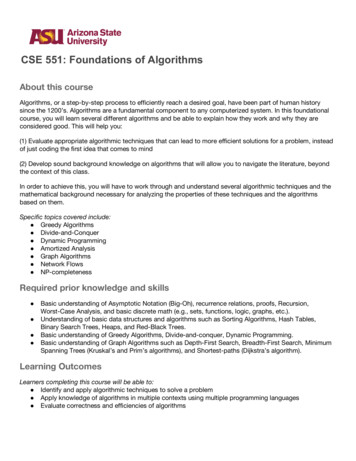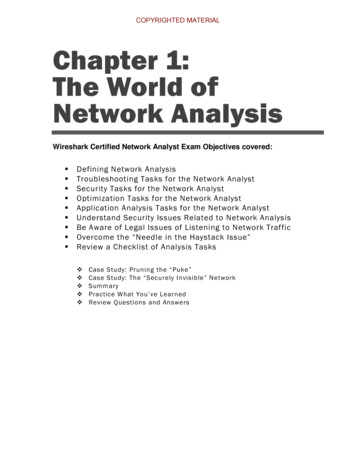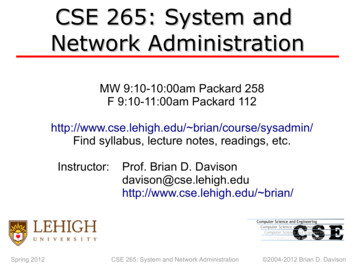
Transcription
CSE 265: System andNetwork AdministrationMW 9:10-10:00am Packard 258F 9:10-11:00am Packard 112http://www.cse.lehigh.edu/ brian/course/sysadmin/Find syllabus, lecture notes, readings, etc.Instructor:Spring 2012Prof. Brian D. .edu/ brian/CSE 265: System and Network Administration 2004-2012 Brian D. Davison
Who is this course for? Students interested in learning–The roles and responsibilities of a computer systemsand network administrator–How to configure & manage their own linux systems–How to diagnose and debug problems–How some of the major system services operate–Why they need to be nice to the sysadminUNIX/Linux familiarity and programmingexperience required (CSE17)Spring 2012CSE 265: System and Network Administration 2004-2012 Brian D. Davison
What will the course cover? Understand the role & responsibilities of a system administratorConfigure the Linux operating systemDescribe the system boot processSetup and manage user accounts and groupsManage the resources and security of a computer running LinuxMake effective use of Unix utilities and scripting languages(bash, Perl)Configure and manage simple network services on a LinuxsystemDevelop an appreciation of the documentation available as partof an installed Unix/Linux systemSpring 2012CSE 265: System and Network Administration 2004-2012 Brian D. Davison
What will it not cover? Networking in depth– Take CSE342 or CSE404 insteadNetwork security in depth–Take CSE343 instead Windows administration Many hardware issues All the details needed for certification–Spring 2012Lots of certification courses availableCSE 265: System and Network Administration 2004-2012 Brian D. Davison
What will it not cover? Networking in depth– Take CSE342 or CSE404 insteadNetwork security in depth–Take CSE343 instead Windows administration Many hardware issues All the details needed for certification–Spring 2012Lots of certification courses availableCSE 265: System and Network Administration 2004-2012 Brian D. Davison
What does a sysadmin do?Spring 2012CSE 265: System and Network Administration 2004-2012 Brian D. Davison
What does a sysadmin do? User account managementHardware managementPerform filesystem backups, restoresInstall and configure new software and servicesKeep systems and services operating–Monitor system and network–Troubleshoot problemsMaintain documentationAudit securityHelp users, performance tuning, and more!Spring 2012CSE 265: System and Network Administration 2004-2012 Brian D. Davison
User Account Management User Ids Mail Home directories (quotas,drive capacities)Default startup files (paths)Permissions, group memberships,accounting and restrictions Communicating policies and procedures Disabling / removing user accountsSpring 2012CSE 265: System and Network Administration 2004-2012 Brian D. Davison
Hardware Management–Capacity planning–Inventory–Hardware evaluation and purchase–Adding and removing hardware ConfigurationCabling, wiring, DIP switches, etc.–Device driver installation–System configuration and settings–User notification and documentationSpring 2012CSE 265: System and Network Administration 2004-2012 Brian D. Davison
Data Backups–Perhaps most important aspect!–Disk and backup media capacity planning–Performance, network and system impact–Disaster recovery –Onsite/OffsitePeriodic testingMultiple copiesUser communication Spring 2012Schedules, restore guaranteesand procedures, loss toleranceCSE 265: System and Network Administration 2004-2012 Brian D. Davison
Software Installation/Maintenance Evaluation of softwareDownloading and building (compiling andtweaking)InstallationMaintenance ofmultiple versions Security Patches and updates User notification, documentationSpring 2012CSE 265: System and Network Administration 2004-2012 Brian D. Davison
System Monitoring–Hardware and services functioning and operational–Capacity –Security –Disk, RAM, CPU, networkPasswordsBreak-insSystem logs Spring 2012ExaminationPeriodic rotation and truncationCSE 265: System and Network Administration 2004-2012 Brian D. Davison
Troubleshooting Problem discovery, diagnosis, and resolution–Root cause analysis–Often quite difficult!Often requires–Broad and thoroughsystem knowledge–Outside experts–LuckExpediencySpring 2012CSE 265: System and Network Administration 2004-2012 Brian D. Davison
Local Documentation Administrative policies and procedures–Backup media locations–Hardware –Software LocationDescription, configuration, connectionsInstall media (or download location)Installation, build, and configuration detailsPatches installedAcceptable use policiesSpring 2012CSE 265: System and Network Administration 2004-2012 Brian D. Davison
Security Concerns System logging and audit facilities–Evaluation and implementation–Monitoring and analysis–Traps, auditing and monitoring programs Unexpected or unauthorized use detection Monitoring of security advisoriesSpring 2012–Security holes and weaknesses–Live exploitsCSE 265: System and Network Administration 2004-2012 Brian D. Davison
User Assistance–Time intensive!–Techniques Help desksTrouble-ticket systems–Software availability and usage–Software configuration settings–Hardware usage, maintenance, and troubleshooting–Writing FAQsSpring 2012CSE 265: System and Network Administration 2004-2012 Brian D. Davison
Administration Challenges–Need Broad knowledge of hardware and softwareTo balance conflicting requirements––– –Short-term vs. long-term needsEnd-user vs. organizational requirementsService provider vs. police modelTo work well and efficiently under pressure24x7 availabilityFlexibility, tolerance, and patienceGood communication skillsPeople think of sysadmins only when things don't work!Spring 2012CSE 265: System and Network Administration 2004-2012 Brian D. Davison
Which OS to learn to admin?Spring 2012CSE 265: System and Network Administration 2004-2012 Brian D. Davison
Why (Red Hat/CentOS) Linux?–Need to use some OS to make ideas concrete–Really only two choices: Windows (I'm not qualified)UNIX (and UNIX-like OSes such as Linux)–Both are useful and common in the real world–Linux is popular, free, and usable on personalmachines, but also handles large-scale services–Red Hat/CentOS is relatively polished, popular Spring 2012I've been using it since 1996There are, of course, many alternativesCSE 265: System and Network Administration 2004-2012 Brian D. Davison
What is Linux?much is courtesy of www.kernel.org Linux is a clone of the operating system Unix, written by a loosely-knitteam of hackers across the Net. It aims towards POSIX andSingle UNIX Specification compliance.Like any modern fully-fledged Unix, Linux includes true multitasking,virtual memory, shared libraries, demand loading, shared copy-onwrite executables, proper memory management, and TCP/IPnetworking.Linux really refers to the kernel – most of the commands that you arefamiliar with are really separate programs, not specific to Linux, andoften are part of the Free Software Foundation's GNU project.Linux was first developed for 32-bit x86-based PCs (386 or higher).These days it also runs on dozens of other processors.Spring 2012CSE 265: System and Network Administration 2004-2012 Brian D. Davison
Brief history of UNIX Originated as a research project in 1969 at AT&T Bell Labs– Berkeley UNIX started in 1977 when UCB licensed code fromAT&T.Berkeley Software Distribution started in 1977 with 1BSD, andended in 1993 with 4.4BSDLicensing costs from AT&T increased, so Berkeley attempted toremove AT&T code, but ran out of funds before completion.Final release of AT&T-free code called 4.4BSD-Lite.– Made available to universities (free) in 1976Most current BSD distributions (FreeBSD, NetBSD, OpenBSD) arederived from 4.4BSD-Lite.Most commercial versions of UNIX (Solaris, HP-UX) are derivedfrom the AT&T codeSpring 2012CSE 265: System and Network Administration 2004-2012 Brian D. Davison
Brief history of Linux Created as a personal project (and stillcontrolled) by Linus Torvalds, a Finnishgraduate student, in 1991Conceived as an offshoot of Minix (a model OS)– Not derived from AT&T or BSD UNIXRed Hat (one of many Linux vendors) foundedin 1993 Kernel v1.0 released 1994 Most recent (Jan 2012) kernel release is 3.2.1Spring 2012CSE 265: System and Network Administration 2004-2012 Brian D. Davison
Where to get answers Linux/UNIX documentation can be found inmany places–Manual pages (man pages, using man command)–Texinfo documents (read with info command)–HOWTOs – focused descriptions of a topic–Distribution-specific documentation–Your favorite Web search engine Spring 2012Will typically find online versions of the aboveCSE 265: System and Network Administration 2004-2012 Brian D. Davison
Where to get answersSpring 2012CSE 265: System and Network Administration 2004-2012 Brian D. Davison
man pages–Usually my first resource–Provide OS installation-specificinformation–Man pages document (almost)every command, driver, fileformat, and library routine–“man -k topic” will list all manpages that use topic–Parameters are not the samefor every UNIX, e.g.:Spring 2012 Linux: man 4 tty Solaris: man -s4 ttyCSE 265: System and Network Administration 2004-2012 Brian D. Davison
man page organization Man pages are divided into sections (somewhat Linux specific)––––––––– Some sections are subdivided–– 1: User-level commands and applications2: System calls and kernel error codes3: Library calls4: Device drivers5: Standard file formats6: Games and demonstrations7: Miscellaneous files and documents8: System administration commands9: Obscure kernel specs and interfaces3M contains pages for math librarySection “n” often contains subcommands (such as bash built-in cmds)Sections 6 and 9 are typically emptySpring 2012CSE 265: System and Network Administration 2004-2012 Brian D. Davison
Where do we go from here?–In this course, I'll assign homework projects thatrequire root access on a RHEL/CentOS 5 system.–In our first lab, you will be provided with a hard drivethat can be used in the Sandbox lab (PL112) with theOS, and root privileges so that you will administer it.–In addition, you can (and should) use –the department Suns for most thingsA CentOS 5 system (on the CSE network) callededgar.cse.lehigh.edu to explore a minimal working systemSee course web page for syllabus and schedule fortopics and readings.Spring 2012CSE 265: System and Network Administration 2004-2012 Brian D. Davison
Spring 2012 CSE 265: System and Network Administration 2004-2012 Brian D. Davison Security Concerns System logging and audit facilities – Evaluation and implementation – Monitoring and analysis – Traps, auditing and monitoring programs Unexpected or unauthorized use detection Monitoring of security


